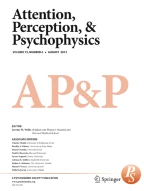Abstract
The operation of attention in the visual field has often been compared to a spotlight. We propose that a more apt analogy is that of a zoom or variable-power lens. Two experiments focused upon the following questions: (1) Can the spatial extent of the attentional focus be made to vary in response to precues? (2) As the area of the attentional focus increases, is there a decrease in processing efficiency for stimuli within the focus? (3) Is the boundary of the focus sharply demarked from the residual field, or does it show a gradual dropoff in processing resources? Subjects were required to search eight-letter circular displays for one of two target letters and reaction times were recorded. One to four adjacent display positions were precued by underlines at various stimulus onset asynchronies before display presentation. A response competition paradigm was used, in which the “other target” was used as a noise letter in noncued as well as cued locations. The results were in good agreement with the zoom lens model.
Article PDF
Similar content being viewed by others
Avoid common mistakes on your manuscript.
References
Beck, J., &Ambler, B. (1973). The effects of concentrated and distributed attention on peripheral acuity.Perception & Psychophysics,14, 225–230.
Colegate, R., Hoffman, J. E., &Eriksen, C. W. (1973). Selective encoding from multielement visual displays.Perception & Psychophysics,14, 217–224.
Coles, M. G. H., Gratton, G., Bashore, T. R., Eriksen, C. W., &Donchin, E. (1985). A psychophysiological investigation of the continuous flow model of human information processing.Journal of Experimental Psychology: Human Perception & Performance,11, 529–553.
DiLollo, V. (1977). Temporal characteristics of iconic memory.Nature,267, 241–243.
Egeth, H. (1977). Attention and preattention. In G. H. Bower (Ed.),The psychology of learning and motivation,11, 277–320.
Eriksen, B. A., &Eriksen, C. W. (1974). Effects of noise letters on the identification of a target letter in a nonsearch task.Perception & Psychophysics,16, 143–149.
Eriksen, C. W., &Colegate, R. L. (1970). Selective attention and serial processing in briefly presented visual displays.Perception & Psychophysics,10, 321–326.
Eriksen, C. W., &Collins, J. F. (1969). Temporal course of selective attention.Journal of Experimental Psychology,80, 254–261.
Eriksen, C. W., &Eriksen, B. A. (1979). Target redundancy in visual search: Do repetitions of the target within the display impair processing?Perception & Psychophysics,26, 195–205.
Eriksen, C. W., &Hoffman, J. E. (1972). Temporal and spatial characteristics of selective encoding from visual displays.Perception & Psychophysics,12, 201–204.
Eriksen, C. W., &Hoffman, J. E. (1973). The extent of processing of noise elements during selective coding from visual displays.Perception & Psychophysics,14, 155–160.
Eriksen, C. W., &Hoffman, J. E. (1974). Selective attention: Noise suppression or signal enhancement?Bulletin of the Psychonomic Society,4, 587–589.
Eriksen, C. W., &Rohrbaugh, J. W. (1970). Some factors determining efficiency of selective attention.The American Journal of Psychology,83, 330–342.
Eriksen, C. W., &Schultz, D. W. (1979). Information processing in visual search: A continuous flow conception and experimental results.Perception & Psychophysics,25, 249–263.
Eriksen, C. W., &Spencer, T. (1969). Rate of information processing in visual perception: Some results and methodological considerations.Journal of Experimental Psychology Monograph,79(2, Pt. 2), 1–16.
Eriksen, C. W., &Yeh, Y. (1985). Allocation of attention in the visual field.Journal of Experimental Psychology: Human Perception & Performance,11, 583–597.
Grice, G. R., Canham, L., &Schafer, C. (1982). Development of associative and perceptual interference.Perception & Psychophysics,32, 375–387.
Hoffman, J. E. (1975). Hierarchical stages in the processing of visual information.Perception & Psychophysics,18, 348–354.
Hoffman, J. E. (1978). Search through a sequentially presented visual display.Perception & Psychophysics,23, 1–11.
Hoffman, J. E. (1979). A two-stage model of visual search.Perception & Psychophysics,25, 319–327.
James, W. (1950).The principles of psychology. New York: Dover. (Original work published 1890)
Jonides, J. (1980). Toward a model of the mind’s eye.Canadian Journal of Psychology,34, 103–112.
Jonides, J. (1983). Further toward a model of the mind’s eye’s movement.Bulletin of the Psychonomic Society,21, 247–250.
Kahneman, D. (1973).Attention and effort. Englewood Cliffs, NJ: Prentice-Hall.
Keren, G., &Skelton, J. (1976). On selecting between theories of selective attention.Perception & Psychophysics,20, 85–86.
Kinchla, R. A. (1974). Detecting target elements in multielement arrays: A confusability model.Perception & Psychophysics,15, 149–158.
Laberge, D. (1983). Spatial extent of attention to letters in words.Journal of Experimental Psychology: Human Perception & Performance,9, 371–379.
Lappin, J. S., &Uttal, W. R. (1976). Does prior knowledge facilitate the detection of visual targets in random noise?Perception & Psychophysics,20, 367–374.
Posner, M. I., Snyder, R. R., &Davidson, D. J. (1980). Attention and the detection of signals.Journal of Experimental Psychology: General,109, 160–174.
Prinzmetal, W., &Banks, W. P. (1983). Perceptual capacity limits in visual detection and search.Bulletin of the Psychonomic Society,21, 263–266.
Shaw, M. L. (1978). A capacity allocation model for reaction time.Journal of Experimental Psychology: Human Perception & Performance,4, 586–598.
Shaw, M. L., &Shaw, P. (1977). Optimal allocation of cognitive resources to spatial locations.Journal of Experimental Psychology: Human Perception & Performance,3, 201–211.
Shiffrin, R. M., &Gardner, G. T. (1972). Visual processing capacity and attentional control.Journal of Experimental Psychology,93, 72–82.
Shiffrin, R. M., &Geisler, W. S. (1973). Visual recognition in a theory of information processing. In R. Solso (Ed.),The Loyola Symposium: Contemporary issues in cognitive psychology. Washington, DC: Halsted Press.
Shiffrin, R. M., McKay, D. P., &Shaffer, W. D. (1976). Attending to forty-nine spatial positions at once.Journal of Experimental Psychology: Human Perception & Performance,2, 14–22.
Skelton, J. M., &Eriksen, C. W. (1976). Spatial characteristics of selective attention in letter matching.Bulletin of the Psychonomic Society,7, 136–138.
Wickens, C. D. (1978). The effects of divided attention on information processing in manual tracking.Journal of Experimental Psychology,105, 1–17.
Yeh, Y., &Eriksen, C. W. (1984). Name codes and features in the discrimination of letter forms.Perception & Psychophysics,36, 225–233.
Author information
Authors and Affiliations
Additional information
This research was supported by Public Health Service Research Career Program Award K6-MH-22014 to the first author and by United States Public Health Service Research Grant MH-Q12006, also to the first author.
Electronic supplementary material
Rights and permissions
About this article
Cite this article
Eriksen, C.W., St. James, J.D. Visual attention within and around the field of focal attention: A zoom lens model. Perception & Psychophysics 40, 225–240 (1986). https://doi.org/10.3758/BF03211502
Received:
Accepted:
Issue Date:
DOI: https://doi.org/10.3758/BF03211502
